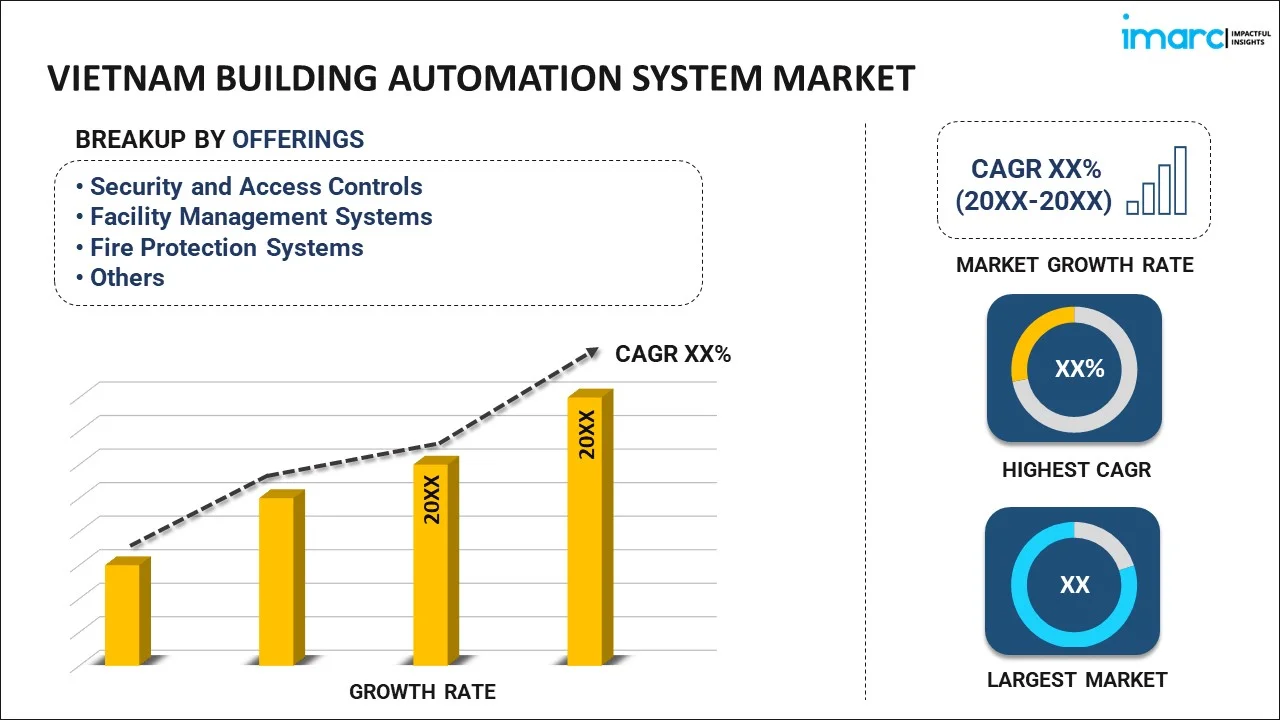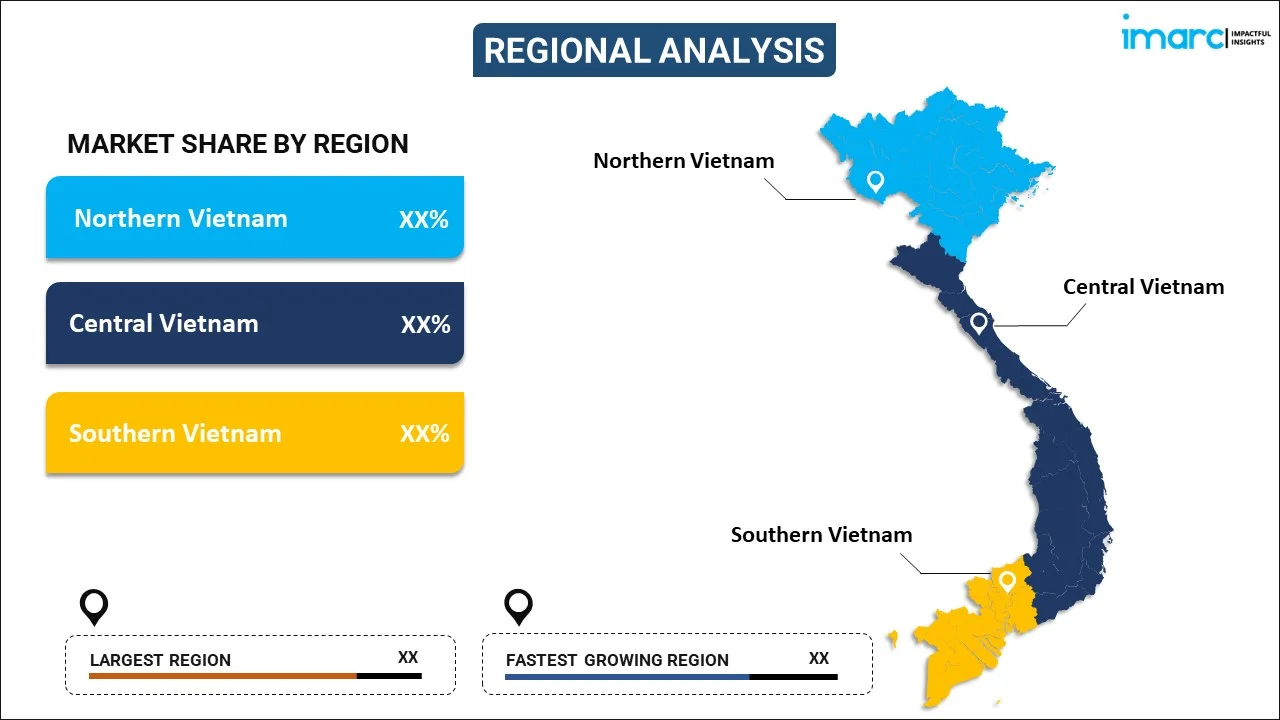
Vietnam Building Automation System Market Report by Offering (Security and Access Controls, Facility Management Systems, Fire Protection Systems, Building Energy Management Software, Building Automation System Services, and Others), Communication Technology (Wireless, Wired), Application (Commercial, Residential, Industrial), and Region 2025-2033
Market Overview:
Vietnam building automation system market size is projected to exhibit a growth rate (CAGR) of 10.10% during 2025-2033. The increasing trend towards smart cities and smart infrastructure that promotes the integration of building automation systems with other smart systems, such as smart grids, transportation systems, and security systems, is driving the market.
|
Report Attribute
|
Key Statistics
|
|---|---|
|
Base Year
|
2024 |
|
Forecast Years
|
2025-2033
|
|
Historical Years
|
2019-2024
|
| Market Growth Rate (2025-2033) | 10.10% |
A building automation system (BAS) is a centralized control system that monitors and manages various building systems to optimize performance, enhance energy efficiency, and ensure occupant comfort. Integrating components like heating, ventilation, air conditioning, lighting, security, and other systems, BAS employs sensors, controllers, and communication networks to gather data and make real-time decisions. By automating routine tasks and responding to environmental changes, BAS aims to streamline operations, reduce energy consumption, and improve overall building functionality. Users can remotely access and control the system through a user-friendly interface, allowing for efficient management and customization of building conditions. BAS not only enhances operational efficiency but also contributes to sustainability goals by minimizing resource wastage and supporting eco-friendly practices within the built environment.
Vietnam Building Automation System Market Trends:
The building automation system market in Vietnam is experiencing robust growth, driven by several key factors. Firstly, the increasing awareness and emphasis on energy efficiency have propelled the demand for BAS solutions. As businesses and industries seek ways to optimize energy consumption, BAS provides a comprehensive approach, integrating systems to monitor and control lighting, HVAC, and other building functions. Moreover, the rise of smart buildings in the era of IoT (Internet of Things) has significantly contributed to the expansion of the BAS market. The ability of BAS to enable seamless communication and coordination among various building components aligns with the growing trend of creating intelligent and connected infrastructures. This interconnectivity enhances operational efficiency and facilitates real-time decision-making, fostering the adoption of BAS across diverse sectors. Additionally, the escalating focus on occupant comfort and well-being has emerged as a pivotal driver for the BAS market. Organizations recognize the impact of a comfortable and conducive environment on productivity and employee satisfaction, motivating the deployment of advanced BAS solutions. Furthermore, stringent regulations and initiatives promoting sustainable practices and environmental responsibility, which cause businesses to invest in BAS to achieve compliance and reduce their carbon footprint, are expected to drive the market in Vietnam during the forecast period.
Vietnam Building Automation System Market Segmentation:
IMARC Group provides an analysis of the key trends in each segment of the market, along with forecasts at the country level for 2025-2033. Our report has categorized the market based on offering, communication technology, and application.
Offering Insights:

- Security and Access Controls
- Facility Management Systems
- Fire Protection Systems
- Building Energy Management Software
- Building Automation System Services
- Others
The report has provided a detailed breakup and analysis of the market based on the offering. This includes security and access controls, facility management systems, fire protection systems, building energy management software, building automation system services, and others.
Communication Technology Insights:
- Wireless
- Wired
A detailed breakup and analysis of the market based on the communication technology have also been provided in the report. This includes wireless and wired.
Application Insights:
- Commercial
- Residential
- Industrial
The report has provided a detailed breakup and analysis of the market based on the application. This includes commercial, residential, and industrial.
Regional Insights:

- Northern Vietnam
- Central Vietnam
- Southern Vietnam
The report has also provided a comprehensive analysis of all the major regional markets, which include Northern Vietnam, Central Vietnam, and Southern Vietnam.
Competitive Landscape:
The market research report has also provided a comprehensive analysis of the competitive landscape in the market. Competitive analysis such as market structure, key player positioning, top winning strategies, competitive dashboard, and company evaluation quadrant has been covered in the report. Also, detailed profiles of all major companies have been provided.
Vietnam Building Automation System Market Report Coverage:
| Report Features | Details |
|---|---|
| Base Year of the Analysis | 2024 |
| Historical Period | 2019-2024 |
| Forecast Period | 2025-2033 |
| Units | US$ Million |
| Scope of the Report | Exploration of Historical and Forecast Trends, Industry Catalysts and Challenges, Segment-Wise Historical and Predictive Market Assessment:
|
| Offerings Covered | Security and Access Controls, Facility Management Systems, Fire Protection Systems, Building Energy Management Software, Building Automation System Services, Others |
| Communication Technologies Covered | Wireless, Wired |
| Applications Covered | Commercial, Residential, Industrial |
| Regions Covered | Northern Vietnam, Central Vietnam, Southern Vietnam |
| Customization Scope | 10% Free Customization |
| Report Price and Purchase Option | Single User License: US$ 3699 Five User License: US$ 4699 Corporate License: US$ 5699 |
| Post-Sale Analyst Support | 10-12 Weeks |
| Delivery Format | PDF and Excel through Email (We can also provide the editable version of the report in PPT/Word format on special request) |
Key Questions Answered in This Report:
- How has the Vietnam building automation system market performed so far and how will it perform in the coming years?
- What has been the impact of COVID-19 on the Vietnam building automation system market?
- What is the breakup of the Vietnam building automation system market on the basis of offering?
- What is the breakup of the Vietnam building automation system market on the basis of communication technology?
- What is the breakup of the Vietnam building automation system market on the basis of application?
- What are the various stages in the value chain of the Vietnam building automation system market?
- What are the key driving factors and challenges in the Vietnam building automation system?
- What is the structure of the Vietnam building automation system market and who are the key players?
- What is the degree of competition in the Vietnam building automation system market?
Key Benefits for Stakeholders:
- IMARC’s industry report offers a comprehensive quantitative analysis of various market segments, historical and current market trends, market forecasts, and dynamics of the Vietnam building automation system market from 2019-2033.
- The research report provides the latest information on the market drivers, challenges, and opportunities in the Vietnam building automation system market.
- Porter's five forces analysis assist stakeholders in assessing the impact of new entrants, competitive rivalry, supplier power, buyer power, and the threat of substitution. It helps stakeholders to analyze the level of competition within the Vietnam building automation system industry and its attractiveness.
- Competitive landscape allows stakeholders to understand their competitive environment and provides an insight into the current positions of key players in the market.
Need more help?
- Speak to our experienced analysts for insights on the current market scenarios.
- Include additional segments and countries to customize the report as per your requirement.
- Gain an unparalleled competitive advantage in your domain by understanding how to utilize the report and positively impacting your operations and revenue.
- For further assistance, please connect with our analysts.
 Inquire Before Buying
Inquire Before Buying
 Speak to an Analyst
Speak to an Analyst
 Request Brochure
Request Brochure
 Request Customization
Request Customization




.webp)




.webp)












